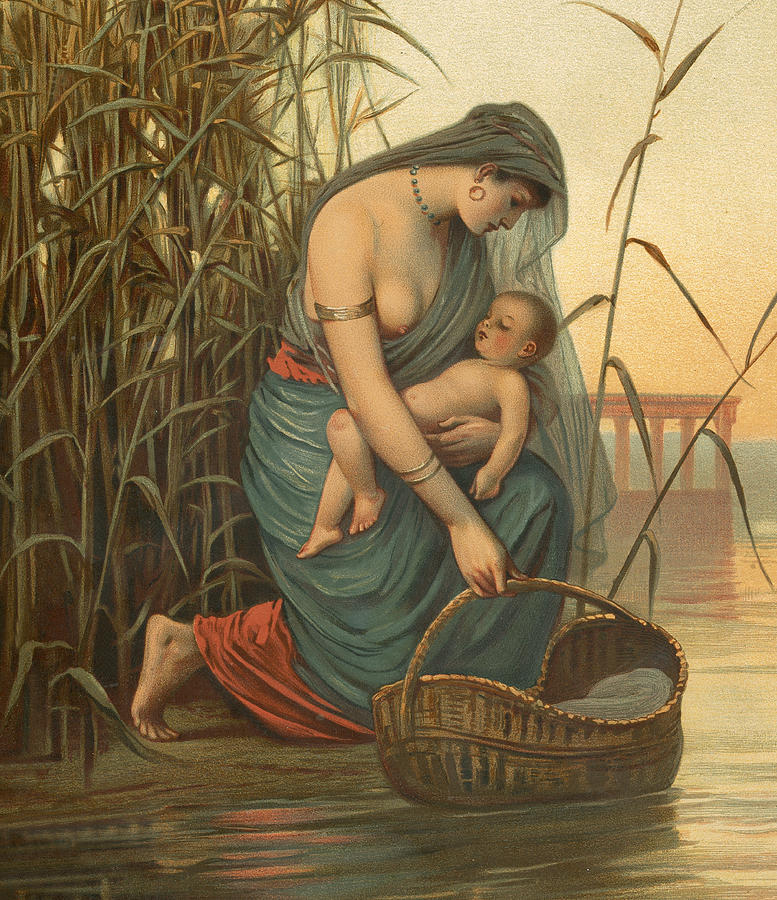Harvest Time (V8)
A Métis lady, drunk -
hands folded, blanketed as in prayer
over a large brown fruit basket
naked of fruit, no vine, no vineyard
inside - approaches the Edmonton,
Alberta adoption agency.
There are only spirit gods
inside her empty purse.
Inside the basket, an infant,
restrained from life,
with a fruity winesap apple
wedged like a teaspoon
of autumn sun
inside its mouth.
A shallow pool of tears mounts
in his native baby blue eyes.
Snuffling, the mother offers
a slim smile, turns away.
She slithers voyeuristically
through near slum streets
and alleyways,
looking for drinking buddies
to share a hefty pint
of applejack wine.
Snuffling, the mother offers
a slim smile, turns away.
She slithers voyeuristically
through near slum streets
and alleyways,
looking for drinking buddies
to share a hefty pint
of applejack wine.

The Infant Moses And His Mother -- Philip Richard Morris
The Métis were initially mixed-race descendants of early unions between First Nations people and colonial-era European settlers (usually indigenous women and settler men), but are now recognized as one of Canada's official aborigibal people with their own culture and communities; the term does not apply to every person of "mixed" heritage or ancestry. The early mothers were usually Mi'kmaq, Algonquin, Saulteaux, Cree, Ojibwe, Menominee, or Maliseet, or of mixed descent from these peoples. These unions were referred to as "marriage à la façon du pays" (according to the custom of the country). After Nouvelle-France was ceded to the British in 1789, an important distinction was made between French Métis and Anglo-Métis (known as "countryborn"'). The most well-known and historically documented mixed-ancestry population in Canadian history were the groups who developed during the fur trade in south-eastern Rupert's Land, primarily in the Red River Settlement (Manitoba) and the Southbranch Settlements (Saskatchewan). In the first stage of development as a distinct froup,"servant" (employee) traders of the fur trade companies, known as wintering partners, would stay for the season with First Nations bands and make a "country marriage" with a high-status native woman. This woman and her children would live in the vicinity of a "factory" (trading post), becoming "House Indians," who eventually formed distinct bands. Many children raised within these "House Indian" bands became employees of the companies, but others became "freemen" traders and trappers. They are about 1/3 of the aboriginal population of Canada and are mainly the descendants of unions between generations of Métis individuals rather than the direct result of intermarriage between First Nations and Europeans.
ReplyDeleteApplejack is a strong apple-flavored alcoholic beverage produced from apples. Jacking meant "increasing" the alcohol content, usually via freeze distillation, a low-infrastructure method of production compared to evaporative distillation. The most common method was to leave the alcoholic fruit beer produced after the fall harvest outside during the winter; periodically the frozen chunks of ice were removed, thus concentrating the unfrozen alcohol in the remaining liquid, resulting in a beverge that would be 25-40 % alcohol.
According to "Exodus" and other texts the Ehyptian pharoah ordered the killing of all newborn Jewish boys. Yoḫeved ("Yahweh is glory"), the wife/aunt of Amram, hid her newborn son for three months, then made a wooden chest of bulrushes, made it watertight with slime and pitch, put the child in it, and set it adrift in the Nile river. The pharaoh's daughter Bithia (whom Josephus called Thermutis/Tharmuth) was bathing by the river and decided to adopt the baby. His older sister Miriam, who was wtching over the baby, volunteered to find a woman to nurse the child, and thus Yoḫeved continued to raise him until he was older. Then she took him to Bithia, who formally adopted him and raised him as part of the royal family, naming him Moshe, saying, "I drew him out (meshitihu) of the water," thus punning on the Hebrew verb "mashah" (to draw out). However, the Egyptian root "msy' (child of) was commonly used in Egpyptian names such as Thutmoses or Ramesses. His name has also been linked to "mou" (water). After killing an Egyptian slavemaster to save the life of a Jewish slave, Moshe fled from Egypt, led thee from Egyptian bondage, gave them the Ten Commandments, and wrote the first five books of th Torah (the Old Testament of the Bible).
ReplyDelete